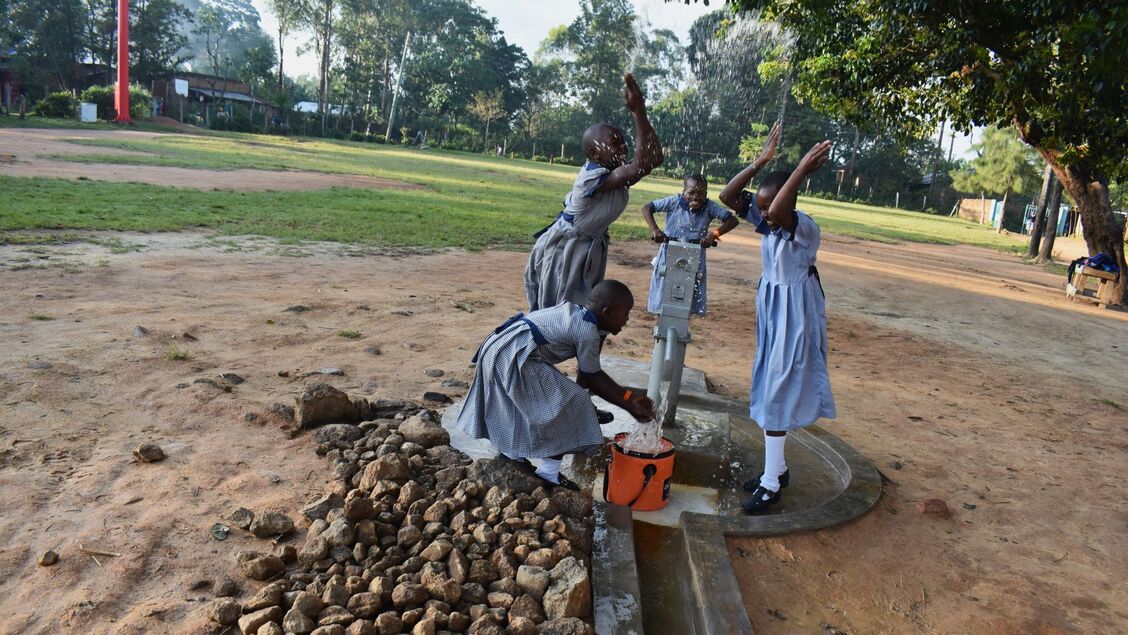Emukaba Project Complete
June 24, 2025

Emukaba Primary School in Kenya now has access to clean water, thanks to the completion of their borehole well! Clean, flowing water is already making a difference in the lives of the students and staff. This will provide them with a reliable water source for their daily needs. Here is the report provided by our implementing partner, The Water Project.
We installed new latrines and handwashing stations, then trained students and staff on improved sanitation and hygiene practices. Together, these components will unlock the opportunity for these students to thrive!
"Because we will not have to leave school to get water, we will have a good time doing our revision and class work. At least now we might get to compete with others while having covered the class work well," said 13-year-old Shamim.
Teachers were just as excited as the students about the new well on campus!
"Having one less thing to worry about is a major gain in the mental and physical presence of students and teachers in school. With that, we will be able to focus our energies towards better performance and growth, as opposed to just regular learning," said 38-year-old teacher Joseph Mudaki.
How We Got the Water Flowing
The first step was to conduct a hydrogeological survey to determine the the best site for the school's well. Once we found the perfect spot, the team obtained approval from the government to begin drilling.
Parents, staff, and students all contributed to this well’s success, right from the start. To prepare for the well, the school collected fine sand and water for cement-making. When everything was ready, our drill team and staff arrived at the school to begin work.
Drilling started with excitement in the air. We continued drilling to reach a final depth of 50 meters with a final static water level of 8 meters.
The drilling process can take up to three consecutive days to complete due to this region’s hard bedrock, so the team set up a camp where they could rest and refuel. The school’s kitchen staff and parents helped provide meals for the team, while the school provided a safe place for the artisans’ accommodations and materials.
Once we reached the optimum depth, the team inserted permanent casing, then bailed out the dirty water at the bottom of the well. The workers installed pipes, flushed them, tested the well’s yield, and chlorinated the water.
We constructed a cement well pad to seal it off from any ground-level contaminants. Tiles were installed beneath the spout to protect the cement from the erosive force of the water. We included a short drainage channel and a soak pit to prevent standing water.
When the well pad was cured, we installed a new stainless steel hand pump and sampled the water for a quality test. The results showed that this water was safe for drinking!
We officially gave ownership of the new borehole to the school’s students and teachers.
Students and staff celebrated the presence of clean water on campus. The event was an excellent chance to acknowledge the school administration and students, and remind them of our continued support. Happiness, thanksgiving, and appreciation were the order of the day, flowing in all directions.
VIP Latrines
This project funded the installation of six new ventilated improved pit (VIP) latrines. These new latrines have cement floors designed to be easy to use and clean. They have locking doors for safety and privacy, as well as vents to keep air flowing out through the roof. With a well right on school property, there should be enough water to keep them clean.
Handwashing Stations
We set up two handwashing stations outside the latrines. Student Health Club members will teach other students how to wash their hands at the stations properly, fill the stations with water, and ensure that there is always soap available.
School Education
We scheduled hygiene and sanitation training with the school’s staff. When the training day arrived, facilitators Betty Muhongo and Stella Inganji deployed to the site to lead the event. 24 students and teachers attended the training.
We emphasized personal, menstrual, oral, and environmental hygiene. Proper water handling, soap-making, the ten steps of handwashing, and the importance of primary health care were discussed. We covered disease prevention, teen pregnancy, and child rights. Waterpoint, latrine, and handwashing station operation and maintenance, as well as leadership and governance were discussed. By the end of the training, each pupil understood their role in sustaining clean water and good health within their school community.
The students elected peers to lead their newly formed student health club. The student health club members will encourage good health and hygiene practices amongst their peers, teachers, and the larger community.
"The attendance for the training met and surpassed our expectations. The headteacher wanted all the students to be trained to have the information firsthand. After a little consulting, he selected some student leaders to be part of the training and tasked them with spreading the information and lessons learned in the training to the rest of the school," shared Field Officer Betty Majani.
The dental hygiene session was popular among participants. "Most of the learners admitted that they rarely cleaned their teeth simply because they lacked toothbrushes and toothpaste," Betty said. Students were encouraged to make caring for their teeth a priority, as it leads to better overall health.
"Some of the topics were very interesting, but I liked the handwashing as we got to learn how to make simple handwashing stations for ourselves. I would like to make one for myself at home," said 13-year-old Dominic.
Thank you to the following for making all of this possible!






























